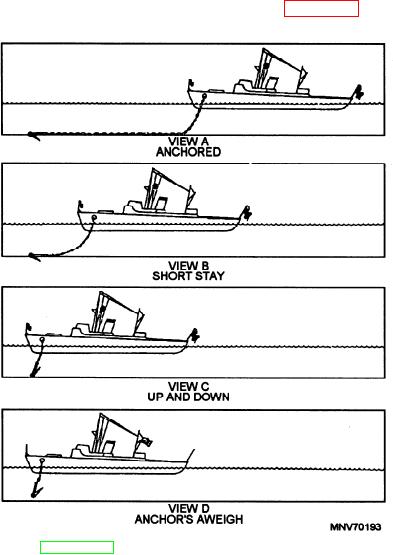
holding, the brake is taken off, and the chain is veered to
weather, a strain much stronger than normal is placed on
the chain. More and more of the chain's length lifts off
the desired scope.
thebottom as the strain increases. When the scope is not
As each chain marking passes the wildcat, the
long enough, the chain lifts all the way to the shank, and
report "(Number) fathoms on deck' is made to the
the anchor breaks out and drags before the chain parts.
conning officer. The direction the chain is tending is
With too long a scope, however, the breaking strain of
indicated by pointing the arm and/or reporting "Chain
the chain is reached and the chain parts before its entire
tending (number) o'clock". Depending on the
length lifts off the bottom.
preference of the commanding officer, the way reports
are given may vary from ship to ship. These reports
Weighing Anchor
enable the conning officer to maneuver the ship
When the ship is weighing anchor, the same gear
properly.
and personnel should be available on the forecastle as
When the desired scope of chain is out, the order
for anchoring. In addition, there must be a grapnel for
"PASS THE STOPPERS" is given. The brake is set,
retrieving the anchor buoy, and a saltwater hose must be
and the stoppers are applied and evened up. The brake is
rigged to wash the mud from the chain and the anchor.
taken off; then the chain is slacked between the windlass
The following procedures are carried out in making
and the stopper. The brake is set, and the wildcat is left
ready for weighing anchor. After the windlass is
disengaged. Before the anchor detail is secured, all gear
energized, the anchor windlass is tested. Then the
must be picked up and stowed.
brake is set, and the riding stopper is cast off and cleared
from the chain. The anchor is now engaged, held by the
Scope of Chain
brake and backed up by the housing stopper. When
Under normal conditions, a ship usually anchors to
everything is ready, the report "Ready to heave in" is
a scope of chain between five and seven times the depth
made to the bridge.
of the water. This is important to prevent losing the
anchor or the anchor and part of the chain in heavy
The ship will be riding on its anchor chain, as shown
weather. When a ship at anchor is subjected to heavy
in view A of figure 7-11. If the wind or current is strong,
Figure 7-11.--A ship from anchored to under way.
7-8

